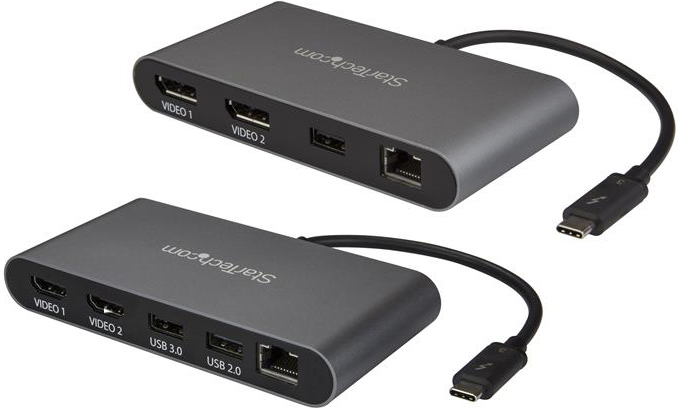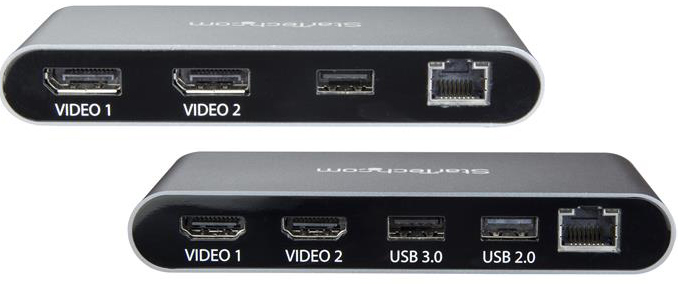StarTech Launches ‘Affordable’ Thunderbolt 3 ‘Mini Docks’: USB-A, GbE, DP or HDMI
by Anton Shilov on May 17, 2018 2:45 PM EST
StarTech on Thursday announced two new Thunderbolt 3 miniature docking stations that the company made more affordable than existing 4-in-1 docks. The Mini Thunderbolt 3 Docks feature two 4Kp60-capable display outputs, a USB Type-A header, and a Gigabit Ethernet controller.
StarTech’s family of Mini Thunderbolt 3 Docks consists of two models: the TB3DKM2DP with two DisplayPort 1.2 outputs enabled by the TI TPS65983 controller and the TB3DKM2HD with two HDMI 2.0 outputs enabled by the Parade PS176 controller. In addition to display outputs, the mini docks feature one USB 3.0 connector driven by ASMedia’s ASM1042A as well as a GbE header controlled by Intel’s WGI210AT chip.
Unlike higher-end Thunderbolt 3 docking solutions from StarTech and other suppliers like OWC and Promise, the TB3DKM2-series cannot charge notebooks (which means that these laptops will need to use an extra TB3 port for charging). Furthermore, since the mini docks are based on Intel’s Alpine Ridge controllers, it's also worth noting that they only compatible with TB3 host ports and can't fall back for pure USB Type-C hosts.
A clear advantage of StarTech’s Mini Thunderbolt 3 Docks over full-fledged docking stations are their miniature sizes as well as lower prices. Their obvious disadvantages are a limited number of USB-A ports and the lack of a model featuring both DisplayPort and HDMI outputs in the lineup (both limitations are conditioned by BOM and production costs).
| StarTech's Mini Thunderbolt 3 Docks at a Glance | |||
| TB3DKM2DP | TB3DKM2HD | ||
| Thunderbolt | Controller | Intel Alpine Ridge JHL6540 | |
| Port | 1 × TB3 connector (input) | ||
| USB | Controller | ASMedia ASM1042A | |
| Port | 1 × USB 3.0 Type-A | ||
| Ethernet | Controller | Intel WGI210AT | |
| Port | 1 × GbE port | ||
| Display Output | Controller | Texas Instruments TPS65983 | Parade PS176 |
| Port | 2 × DisplayPort 1.2 (up to 4Kp60) |
2 × HDMI 2.0 (up to 4Kp60) |
|
| MSRP | $164 | $183 | |
| Additional Details | Link | Link | |
StarTech.com’s Mini Thunderbolt 3 Docks will be available directly from the company as well as from leading retailers like Amazon, CDW, and other. The TB3DKM2DP mini dock with two DisplayPort 1.2 headers costs $122 from Amazon and $164 when bought directly, whereas the TB3DKM2HD with two HDMI 2.0 outputs will be available for $183 in the coming weeks when acquired from the manufacturer.
Related Reading:
- StarTech’s New Adapter Brings eSATA Storage to Thunderbolt 3 PCs
- StarTech Launches Thunderbolt 3 USB Hub with 3 USB 3.1 Controllers & Power Delivery
- StarTech's Thunderbolt 3 to Dual 4Kp60 Display Adapters Now Available
- Promise Launches TD-300 9-in-1 Thunderbolt 3 Dock: GbE, HDMI, USB 3.0, TB3 Charging & More
- OWC Launches 13-Port Thunderbolt 3 Dock: GbE, USB-A, SD Card, mDP, FireWire & More
- StarTech Unveils Dual-Display Thunderbolt 2 Docking Station with 12 Ports
- AKiTiO Displays Thunderbolt 3 to 10GBase-T Adapter











18 Comments
View All Comments
HStewart - Thursday, May 17, 2018 - link
I actually purchase one of these docks and had issues with on my XPS 15 2in1 - I was hoping to have it for possible portable solution but the problem is that even though it supply my monitor via Display Port - USB port did not workSo what I decided to is return this dock to amazon and get the Pluggable USB-C dock - I use this on my less powerful Dell XPS 13 2in1 and Samsung Tab Pro S But on my XPS 15 2in1 - currently I using a Dell TB-16 connected to LG 34U88-B along with USB ports mouse keyboard.
I am pretty sure that I can run it along with my Samsung 4k monitor - not sure if it can handle 2 4k screen ( 15 2in1 is 4K ) and 34 UltraWide. - but over thunderbolt it could be possible.
lmcd - Monday, May 21, 2018 - link
The reason for this is that Dell's XPS line's Thunderbolt ports are not the full bandwidth (at least in the year my model is from).karatekid430 - Sunday, May 27, 2018 - link
They fixed it. Yeah, it was a joke.Dell 9365 = 15D9 (but ironically not enough processing power to take advantage of it)
Dell 9370 = 15D2 (I came from the 9365 to 9370 and the performance of this one is stunning)
Dell 9575 = 15D2 (I even put the NVM firmware from this model on my 9370)
Dell 9570 = 15D9 (Full bandwidth at least, but still a let down when the smaller 9370 has more ports).
If it helps, it does not actually half the bandwidth using PCIe 3.0 x2 - because the Thunderbolt 3 has a 22Gbps limit on PCIe. So you drop from 22Gbps to 16Gbps. You do not get the full 32Gbps through Thunderbolt. I guess it was to make room for the DisplayPort. But many devices do not use that - such as eGPUs which generate their own video to send to the monitor. It would be nice if they could unlock the extra bandwidth for non-DisplayPort devices.
Also, this means they are full of faeces - comparing 40Gbps Thunderbolt 3 to 10Gbps USB is a bit misleading. It would be 22Gbps to 10Gbps. And USB 3.2 doubles to 20Gbps exclusively over USB-C cables.
cerberusss - Friday, May 18, 2018 - link
For 219 US$ shipped, get a decent true powered Thunderbolt 3 dock:https://mymantiz.com/products/md-01-zeus
Not shilling, just a customer who is amazed that someone can bring a dock to market with that price.
benedict - Friday, May 18, 2018 - link
The lack of headphones jack makes all those hubs useless.psychobriggsy - Friday, May 18, 2018 - link
Still very expensive for Ethernet and video breakout.I think the BOM is only going to drop when Intel makes a Thunderbolt controller that has the DP, Ethernet and USB3 controllers built in as well.
Why no front-panel USB ports? Surely the USB controller can provide for more than one or two ports?
Additionally, why not DP + miniDP, that would have provided the room for two USB ports on that configuration as well.
edzieba - Friday, May 18, 2018 - link
" Furthermore, since the mini docks are based on Intel’s Alpine Ridge controllers, they are not compatible with PCs featuring USB Type-C headers."Eh? It depends on whether the Type C port on the host PC is a Thunderbolt port or a regular USB port. A PC with a Thunderbolt Type C port will work with one of these docks just as any other Thunderbolt host device.
Unless you're specifically referring to the internal Type C motherboard header, in which case it's down to whether a particular motherboard has routed a Thunderbolt output to that port, or just fobbed it off with USB only. The header itself is required by the spec to be electrically compatible with all transports the normal Type C connector can carry.
karatekid430 - Sunday, May 27, 2018 - link
Why would they use an Asmedia USB controller when the JHL6540 has a USB controller built in? It seems like a waste, and plus Asmedia is largely responsible for the vulnerabilities in the AMD chipsets, I'd imagine (they were contracted to make them). Also they could at least have made the cable detachable - I want the ability to swap the cable for a 2M Active, and share the same cable with multiple accessories.